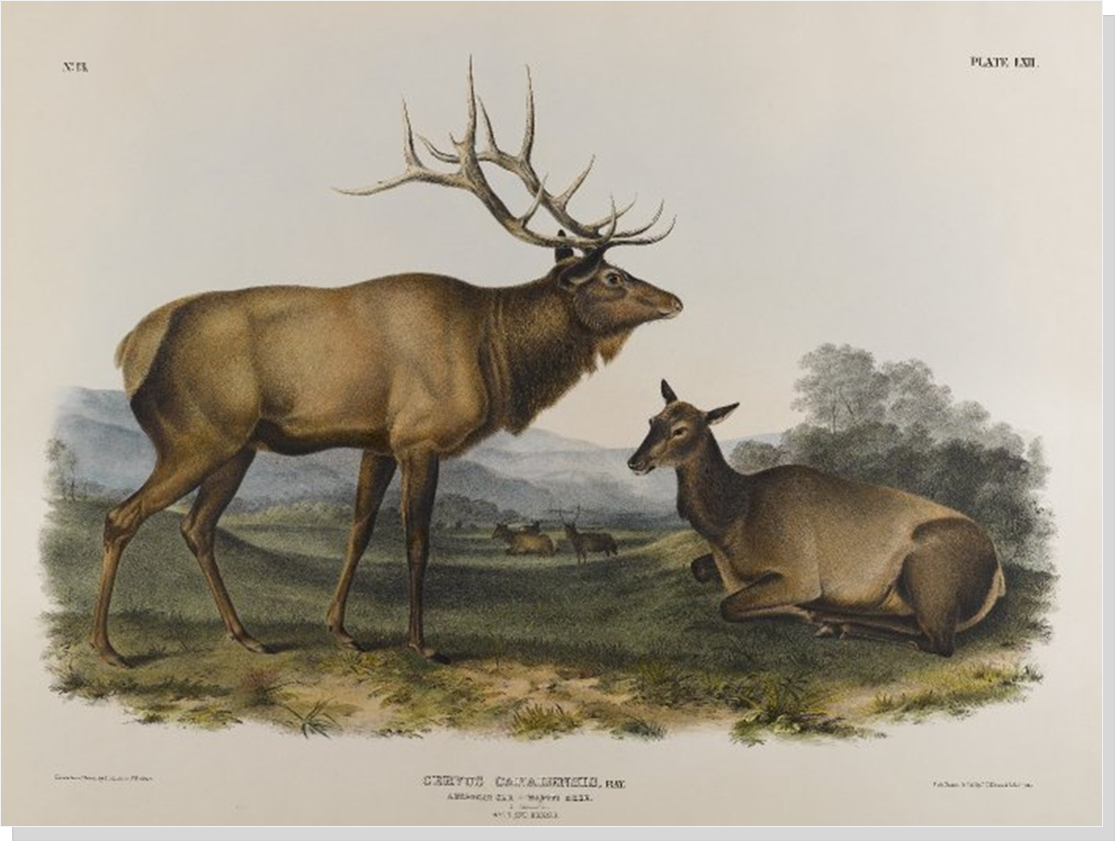
VIEW ON NATURE: Coming Home
By: Stephen L. Wendt
 Illustration of the extinct elk subspecies Cervus canadensis canadensis John James Audubon,
Illustration of the extinct elk subspecies Cervus canadensis canadensis John James Audubon,
from the collection of the Brooklyn Museum titled, “American Elk”, circa 1845.
The haunting, echoing sound started as a low-pitched bellow that swelled into a high-pitched scream…an unmistakable trumpeting I will never forget!
I knew I was close to what I had come to see, a wild bull elk in “the rut” calling for mates and warding off competitors. But what may surprise you is I wasn’t in the western US but in southwest Virginia witnessing a ritual of days past in the Commonwealth.
Elk are indeed native to Virginia. Explorers in the late 1600s described abundant elk herds, particularly in the New River and Shenandoah Valleys. Eastern elk were previously found throughout the eastern North America but by the late 1800s were wiped out by over-hunting and farming. The last of Virginia's original elk herd was killed in 1855 in Clarke County, VA, and the subspecies was declared extinct across its native continental range in 1880.
These are BIG animals, with a full-grown bull weighing up to 1,000 pounds, standing up to 60 inches tall at the shoulder, and carrying a rack of antlers up to 6ix feet in length! What’s more exciting is elk have been successfully re-introduced into our state with the herd flourishing from an original group of 75 to now more than 250 and expanding. Those “seed” elk came from neighboring Kentucky which today has at least 11,000 elk thriving on 4 million acres immediately east of Virginia, representing the largest such herd east of the Mississippi river.
Through the refreshing collaboration among the Virginia legislature, the Virginia Department of Wildlife Resources (DWR), and many community and other associations and their counterparts in Kentucky, elk restoration is Virginia is happening. The focus on elk management is rooted in a published 10-year habitat management plan that is working.
Elk mostly feed on grasses and open land forage which inspired Virginia to address two challenges at once -- restore former coal surface strip mines lands with vegetation while providing the food resources and habitat needed to nurture, increase and manage a growing elk herd. All the while the elk rely on the adjacent mountainous forest lands to feed on understory plants, seek relief from the summer heat, and avoid humans. From the increase in their numbers, this combination is working, whereas several previous, less managed attempts at seeding elk in years past failed. And the Virginia DWR have noticed that the restoration has similarly benefited many other species such as whitetail deer, black bears, wild turkeys, ruffed groused, small mammals, grassland birds, and more.
For those who are unable to drive to Buchanan County Virginia to witness wild elk, the Virginia DWR (https://dwr.virginia.gov) is thinking of you. Working with sponsors, the DWR has arranged for a live broadcast of key remote locations frequented by elk within their range using trail video cameras linked to their website. By visiting their website you can tune into their “Elk Cam” to see wild elk caught on camera. Who knows, you may even tune in to hear their spine-tingling, trumpeting mating call, the most fantastic natural call in Virginia. You will never forget. Elk Cam: https://dwr.virginia.gov/blog/elk-cam-kicks-off-its-2021-season/

Creative Commons CCO 1.0 Jasper.Wapiti-Hirsch
This story can be read in full along with other VIEW ON NATURE stories in The ENDEAVOR News Magazine at www.annandalechamber.com/theendeavornewsmagazine.rhtml Reproduction of this story in whole or in part requires the written permission of The ENDEAVOR News Magazine
(Copyright © 2012 Annandale Chamber of Commerce. All rights reserved. (Photographs & images, on this page, and on this website, are not available for use by other publications, blogs, individuals, websites, or social media sites.)
Copyright 2012 Annandale Chamber of Commerce. All rights reserved. Privacy Policy

